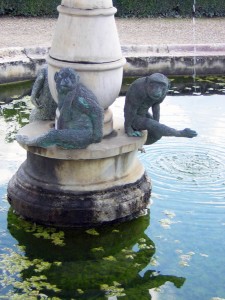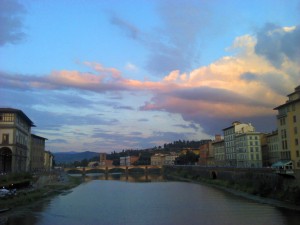Bathroom Suspense
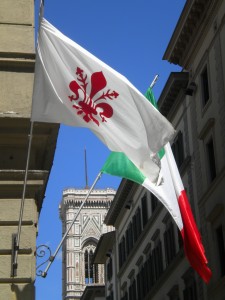 American friends who have traveled extensively in Italy, or some other regions of the Earth, smile with an instant, knowing understanding when I say “bathroom suspense.” I grew up to expect going to the bathroom to be simple, relaxing, an almost unthinking break in which simple repetition and the brief suspension of work and interaction allows for a defragmenting mental breather. In Italy, instead of relaxation, suspense: “How will this bathroom not work?”
American friends who have traveled extensively in Italy, or some other regions of the Earth, smile with an instant, knowing understanding when I say “bathroom suspense.” I grew up to expect going to the bathroom to be simple, relaxing, an almost unthinking break in which simple repetition and the brief suspension of work and interaction allows for a defragmenting mental breather. In Italy, instead of relaxation, suspense: “How will this bathroom not work?”
The cause is simple: the buildings predate modern plumbing, so the bathrooms are tucked and tweaked in by force in often inconvenient and inhospitable architectural circumstances, but remembering the last time I had to replace a toilet in my own house, and browsed at Home Depot through the endless row of nearly-identical, “American Standard” toilets, I can’t help but think that the equivalent should be named, “Italian Chaos.”
Bathroom Suspense has two primary forms.
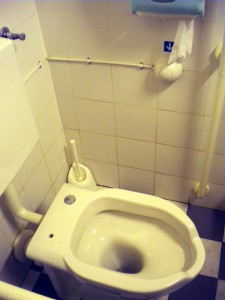
The first, and briefest, is hunting for the flush. Many times a week when traveling one enters an unfamiliar bathroom, in a restaurant, hotel, train station, and there is very often an unsettling, sometimes extended hunt for the operating mechanism that commands the exodus. Will it be a pull chain dangling from the ceiling? A foot pedal? A button on an extended wire somewhere random in the room? A ceramic mechanism that looks like wall art, or alternately an enormous metal button that looks more like an emergency trigger than a flush, and won’t budge unless you lever your full bodyweight against it? Even simple-seeming mechanisms, such as the common large plastic button on top of the tank, present complexities: which of two buttons is the right one? Or, worse, sometimes there is only one button but it turns out to be a hinged panel which does different things when you push the left side or the right. It generally only takes a few seconds’ experimentation to solve the mystery, but it is enough to turn calm into stress, much as if one were immersed in a novel only to discover that the last ten pages are glued together and need to be separated with a letter opener: annoyance destroys the moment.
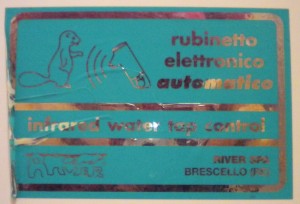
I have also often had friends return from a public restroom with rather uncomfortable faces to confess that they gave up and couldn’t find the flush, or, more often, the sink controls: “Oh, that sink is controlled by a pair of color-coded foot petals behind the trash can.” And it doesn’t help anglophones that caldo = hot and freddo = cold, therefore the hot tap is labeled “C”.
A large number of Italian toilets are also bizarre in other ways, with no seat, or a seat that pushes itself up automatically so you have to hold it down while trying to sit, or a seat that squirts itself with disinfectant at unpredictable moments. Most infamous is the rare squat toilet subspecies, lurking patiently in the innocent-seeming stalls at museums and coffee bars. Many are unaware that squat toilets exist in a civilization that had proper toilets more than two thousand years ago. Even if one is aware, they are always still startling and awkward, as if one checked into a hotel room and went to throw one’s coat and backpack on the bed only to discover a hammock in its place: doable but weird, and not the kind of surprise you want mid-travel.
Shape adds another element to the complexity of the Italian public restroom, since these are, after all, crammed into awkward corners of Renaissance if not Medieval homes. Many bathrooms are trapezoid, rhomboid, have strange beams or blocks of stone protruding into them, or deep former windows through foot-thick stone walls covered over with something as ephemeral as waxed paper.
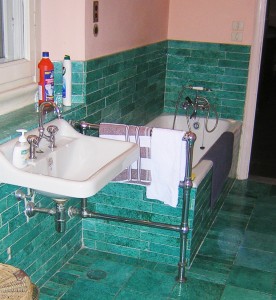
Pipes trail along the corners and bunch around rare openings, like tree roots desperate to claw their way through rock. All this makes the brief moment of bathroom going a disruptive and memorable garnish to the museum trek or hotel night; simplicity is now adventure.
Hotel rooms have the extra resource of a shower to add surrealism to the moment. I encountered an excellent example in Milan last summer. It is not uncommon for an Italian bathroom to have no shower-height shower head, but instead to have only a low bathtub-height faucet, or more commonly a spray nozzle on the end of a hose, so one may sit or stand while holding it, and generally shower with reasonable success so long as one is careful to aim into the tub (which is often not guarded by any shower curtain). Here, I discovered with some satisfaction that there was, in fact, a shower-height wall nozzle—jubilation!—if positioned a little oddly. This shower had a formal bathtub positioned with one long side against the wall of the bathroom, and the nozzle was in that wall in the precise center of the tub’s length, so one stood, not at one end, but in the middle to be in the water’s course.
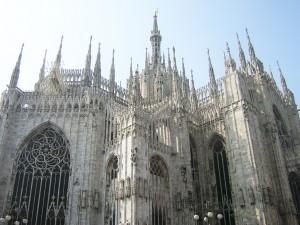
This would have been excellent if not for two factors. One: the nozzle didn’t point down, it pointed out, spraying the water completely past the tub toward the unguarded center of the room with a force sufficient to knock the shower curtain aside and drench the bathroom. Okay, sure, this was surmountable if one took great care to position one’s self between the water jet and the room at all times, using one’s body to deflect the force. However. There was a lower nozzle, for filling the bath, flanked as many are by two taps, one cold one hot, so one could mix the water and achieve the desired temperature: good so far. Yet, for the upper shower-height one, there was only one tap, hot. Very hot. Scaldingly hot, in fact, with no possibility of dimming its force with any cold. So, to shower, one had to stand in the middle of the bathtub and, shielding the room with one’s body, take full brunt of a powerful jet of literally burning hot water.
But this is only the lesser form of Bathroom Suspense. The true form comes in renting an apartment, and committing, sight unseen and from across the Atlantic, to six months with a bathroom which may well turn out to be another tier of Purgatory.
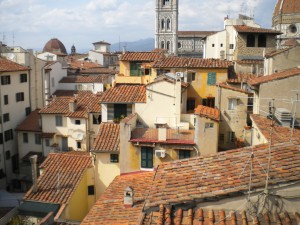
Before I turn to the outstanding examples, let me say that I love my current bathroom. It is wonderful, by far the best I have had in any Italian apartment. It’s bliss. It is a peculiarly long thin space, narrow enough that one must take care stepping around the fixtures, and one must move sideways through it at all times, as well as entering sideways, since the tiny bathroom door is four inches narrower than my shoulders. There is a window above the toilet looking out on the beautiful skyline and Giotto’s bell tower, which for me is at eye height when I’m sitting on the toilet, has no frosting, shutter or curtain, and an excellent view of several other nearby apartment windows, often occupied. The shower follows a common trend and has no actual shower bed or rim, it is simply a nozzle that squirts hot water into the bathroom and a drain in the slanted tile floor to which the water, after adventuring across the bathroom, returns and exits. There is a shower curtain (wonderful!) and a fine sink. Oh, and the toilet requires my full bodyweight to flush, and the button has to be pressed so it actually recedes into the wall, so I have to throw my full weight against my thumb, not my palm, to activate it. The water is gas heated, rather than electric, a great energy savings, but it does mean one has to turn the gas on before (and off after) every shower, and the activation mechanism is clear on the opposite side of the apartment by the front door, requiring either foresight or a quick dash in a bathrobe if one forgets. It only takes about a minute and a half for the water to get hot, though, which is excellent. My landlady warned me that the water pressure was low, since we are, after all, at the top of a medieval tower, and she even installed an electric pump to increase the flow, but I don’t use it, finding the water pressure perfectly sufficient and comparable to American Low Flow (Low Flow is a concept which will, I suspect, never penetrate a country whose towns are filled with lovely free-flowing public fountains pouring gallons of drinkable water down the drain every second). Please don’t read any sarcasm into this description. This is the best bathroom I have had in an Italian apartment, and I am absolutely delighted.
For those skeptical, let me now describe the worst bathroom I have endured in an Italian apartment. The title does not go to the Roman apartment which offered precisely 1 minute 43 seconds of hot water followed by ice shock, nor to the Florentine apartment with the bathtub in the middle of the room and no curtain, requiring the most delicate aim with the hand-held nozzle. Another Florentine place where the gas was actually inside the shower so you had to keep an eye on the fire while showering, was also more a case of character than discomfort. No, the winner is a little place in Florence’s Oltrarno district, which used to belong to the Machiavelli family, whom I do not blame.

Let me first highlight the important fact that, through all this chaos of chain-operated levers and incomprehensible knobs, and in most women’s public restrooms as well, there is always, inevitably, identically, beautifully and functionally, a bidet. I’m certain that for those who grew up using a bidet its absence in American restrooms must be annoying if not disgusting, but coming from a bidet-free culture (and often having to explain to guests what that “little low sink thing” is next to the toilet) I can stay with confidence that a bidet is not necessary for the bathroom process. Convenient, comfortable for those accustomed, but you can totally succeed in the whole bathroom experience without one. (For those unfamiliar: you wash your bottom with it.) So will someone tell me why, with so many barely-functional showers and sinks that require you to pump a priming handle, the least necessary component of the bathroom is the most reliable?
In the Machiavelli bathroom, the bidet was perfect. The toilet was reasonable, requiring minimal massage of the mechanism to coax a flush out of it, but the shower nozzle was positioned almost directly above it, so while showering one had to either literally straddle the toilet or teeter in the narrow space between toilet and bidet. There was again no rim around the shower area, it simply flowed freely into the bathroom, which had a drain in the middle of the floor, but while the very excellent bathroom I am currently enjoying has well-sloped tile to direct the water efficiently to the exit, in this one the water flowed merrily all around the bathroom, completely flooding it. And this bathroom had no lintel. So the water flowed merrily out of the bathroom to the space outside. Did I mention this bathroom was situated on a landing half-way down a flight of solid stone steps between my bedroom and the outer door? And that said stone stairwell was completely unheated? Thus if the water made it out the door in winter, sheets of ice were instantly produced, coating the landing and glittering merrily down the steps from bathroom to street. To prevent this, a squeegee on a long pole was provided, and while showering one had to periodically pause and squeegee the water away from the doorway back to the drain, an exercise rather like raking leaves, only when naked and wet. And cold.
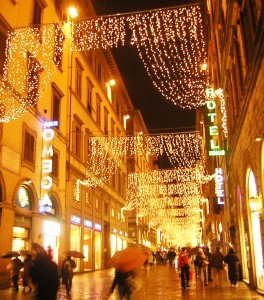
Cold was the true centerpiece of this bathroom. Italian stone architecture is brilliant in summer at using the natural cave-like coolness of stone and shade to create cool spaces without air conditioning, but the winter converse is not fun when the bathroom is just about as unheated as the stone stairwell outside. It was freezing—sometimes literally—inside that bathroom, and rather than fog there would be lovely frost patterns on the mirror after a shower. Returning through the sub-zero stairwell from bathroom to bedroom with wet hair required a deal of moral fiber as well. Did I mention that this apartment was so cold that, in winter, I slept in my clothes, and my wool coat, and my super-thick camping socks, and my winter boots? Getting out of my wintry bundle to strip off in a freezing bathroom was… character building. Fine, good, we can deal with this, the cold should make the shower even more blissful, because the treasured immersion in streaming hot water is the one daily opportunity to be truly warm. Right? No, reader, I will not leave you with so predictable a punch line as to say there was no hot water, or that the water ran out after a few moments, or took forever to get warm. Such mediocrities are unworthy of a property which might have at some point maybe belonged to Machiavelli’s uncle.
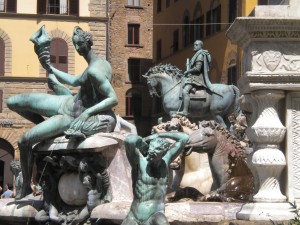
The shower had a simple nozzle. Half the holes produced completely frigid, barely-above-freezing cold water. The other half produced blistering burn-yourself-from-touching-it you-could-make-tea-with-this hot water. With no mixing. Thus, the full shower experience involved stripping off cuddly warm winter wear in freezing temperatures, then straddling the toilet only to stand with my teeth chattering as freezing water cascaded over part of me, while other areas of skin are burned red by the scalding heat. While periodically stopping to squeegee. Comfy as covers are, never before or since has getting out of bed in the morning literally been torture. This, ladies and gentlemen, is a true Italian bathroom, and I would not trade my current gas-activated heat and oddly-positioned window for all the treasures of the Medici. Well, maybe for their Botticellis.


